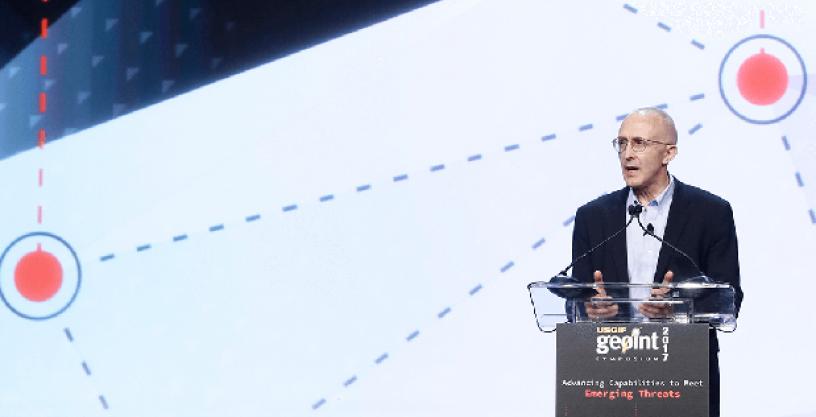
NGA Director of Research and DARPA Alum Joins Leadership Team As Agency Enters 60th Year
Jan 8, 2018
The director of the U.S. Defense Advanced Research Projects Agency (DARPA), Dr. Steven Walker, today announced the appointment of Dr. Peter Highnam as deputy director of the Agency. Highnam, a former DARPA program manager, is expected to help advance critical research in several fields including artificial intelligence, data analytics, communications, reconnaissance, electronic warfare, biosecurity, and warfighter health.
Highnam succeeds Dr. Stefanie Tompkins, a ten-year veteran of DARPA, who has served as the acting deputy director of the Agency since January 2017 and departs this month after being named the vice president for research and technology transfer at the Colorado School of Mines in Golden, Colo.
Highnam comes to DARPA following an assignment from the Office of the Director of National Intelligence (ODNI) to the National Geospatial-Intelligence Agency (NGA) where he was responsible for the Agency’s research organization for the past two and a half years. Prior to this assignment he served six years at the ODNI Intelligence Advanced Research Projects Activity (IARPA), initially as an office director, and then as director. While at IARPA Highnam was also involved in government-wide high performance computing (HPC) activities, including the National Strategic Computing Initiative and the Department of Energy exascale initiative. Before IARPA he worked for six years in the U.S. Department of Health and Human Services (HHS).
As a senior advisor in the National Institutes of Health (NIH), Highnam had responsibilities in multiple areas where high performance computing intersects with biomedicine and public health, including computational epidemiology. As senior advisor in the Biomedical Advanced Research and Development Authority (BARDA), he produced analyses related to chemical, biological, radiological, and nuclear events, as well as naturally occurring disease, in support of public health decision-making.
From 1999 to 2003, Highnam was a DARPA program manager working in electronic warfare and airborne communications. His research in electronic warfare (Advanced Tactical Technology (AT3) program) focused on inexpensive approaches to rapidly and accurately target enemy air defense radars from greater standoff distances. Also, Highnam investigated technology for high performance, flexible, and secure networked communication between tactical aircraft (Tactical Targeting Technology (TTNT) program), enabling plans to move away from systems such as Link 16.
Highnam worked for more than a decade in applied research at Schlumberger Limited where he implemented industry-changing seismic data analytics on massively parallel computers. He also served as a director of a successful biomedical imaging startup company.
Highnam holds a Department of Health and Human Services Secretary’s Distinguished Service Award and a Department of Defense Civilian Exceptional Service Award. He is a co-inventor on three patents in commercial seismic exploration and holds a doctorate in computer science from Carnegie Mellon University.
About DARPA: Established in 1958 as part of the U.S. Department of Defense, DARPA is designed to anticipate, explore, and achieve the concepts and technology on which the nation’s future deterrent and defense capabilities depend. It does so collaboratively as part of a robust innovation ecosystem that includes academic, corporate, and governmental partners. And while its focus is always on the Nation’s military Services, which count on DARPA to create new strategic and tactical options, DARPA’s work has historically catalyzed fundamental breakthroughs that have benefited the broader society as well.
The Agency, located in Arlington, Va., supports approximately 210 government employees, about half of whom are program managers. Its research is conducted by a wide array of public- and private-sector performers via 2,000 contracts, grants, and other agreements. DARPA’s FY 2017 budget is $2.89 billion.
# # #
Media with inquiries should contact DARPA Public Affairs at outreach@darpa.mil
Associated images posted on www.darpa.mil and video posted at www.youtube.com/darpatv may be reused according to the terms of the DARPA User Agreement, available here: http://go.usa.gov/cuTXR.
Tweet @darpa
